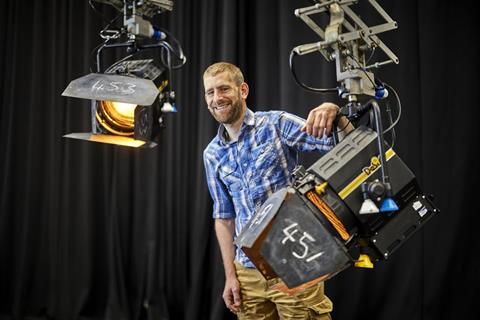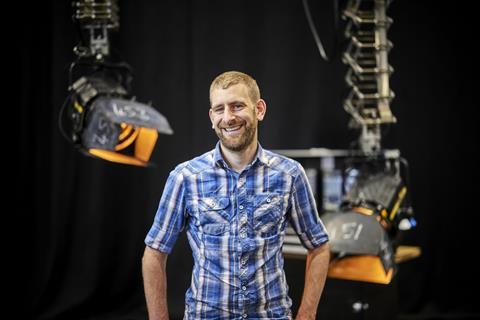Oliver Howe, duty operations manager at dock10, looks at the past and future of lighting in TV and film

From the earliest days of theatre mankind has been aware of the importance of light to a successful show.
The earliest Greek theatres were built facing from east to west, meaning that sunlight – the precursor to modern studio lighting – would illuminate the actors, but not get in the eyes of those seated in the orchestra, or indeed the audience, facing the stage.
This tradition of utilising natural light was continued by the Romans, and then by the earliest Modern English theatres which were built with a large circular opening in the roof – see Shakespeare’s Globe for a surviving, albeit in reconstructed form, example.
Of course, it didn’t take too long for early English dramatists to note that, while an outdoor theatre utilising the light of the sun may be all very well on the streets of Athens or Rome, to borrow a metaphor from another popular modern form of theatre, it didn’t necessarily cut it on a rainy Tuesday night in Stoke.
The first recorded indoor theatre in England was St Paul’s in 1575, followed a year later by Blackfriar’s – the theatre for which Shakespeare specifically wrote The Tempest.
These early indoor theatres used candles to light the performance space, and the new theatrical environment led to a number of practical changes in the way plays were approached. For one thing, the new, smaller, indoor spaces had less room for grand battle scenes and epic choruses, leading to a tendency towards more intimate, personal storytelling. Another notable change came in the need for more pronounced breaks between scenes so the candles could be replaced as required.
Following the victory of Oliver Cromwell in the English Civil War domestic theatres were closed, but theatrical lighting continued to develop in Europe, particularly Italy, where it was witnessed by the exiled Charles II. The returning king would bring the continental use of chandeliers and sconces back with him following the restoration of the monarchy (and the theatres) in 1660.
By the 1670s, London’s Hall Theatre was recorded as using footlights – still burning candles – and by 1689, Frederick Penzel’s Theatre Lighting Before Electricity notes that oil lamps had also entered the theatre’s repertoire.
Very little would change in the world of theatre illumination for more than a century. However, as in so many industries of the time, in the 19th century things began to advance apace.
The first major advancement in the opening decades of the century was the replacement of oil lamps with the gas variety, which allowed the intensity of lighting to be controlled from a distance for the first time by varying how much gas was supplied to the lamps – the earliest lighting desks were born. Light could also be manipulated more effectively by varying the direction of flame and using mirrors. The first recorded theatre to go fully gaslit, in 1816, was Chestnut Street Theatre in Philadelphia.
In 1836, a variation on the use of gas to create a new form of theatrical lighting quite literally ‘entered the limelight.’ The limelight effect was first discovered by the English surgeon and chemist Goldsworthy Gurney, while researching his oxy-hydrogen blowpipe in the 1820s. Gurney discovered that by heating calcium oxide, AKA quicklime, to 2,572C with a gas flame, the substance would burn with a bright, incandescent glow.
The invention’s initial use was in surveying. Its first recorded use in theatre was on the night of October 3, 1836, to illuminate a juggling performance by magician Ching Lau Lauro at Herne Bay Pier in Kent. The flyer advertising the performance called it “koniaphostic light” and described how “the whole pier is overwhelmed with a flood of beautiful white light.”
Ching Lau Lauro’s name has largely been lost to history, but the term “in the limelight” survives to this day, although electric lighting has long since superseded the not entirely health and safety-friendly practice of burning gas and volatile chemicals.
It’s not known exactly how many theatres were burned down or severely damaged by fire during the era of gas and limelight, but suffice to say it was several across Europe. In 1878, however, Joseph Swan patented the world’s first incandescent electric lamp, The following year, Edison demonstrated his first carbon filament light bulb.
The likes of Heinrich Göbel, Humphry Davy, Michael Faraday and Nikolai Tesla also played notable roles in the development of the earliest electrical lights, but it was Swan’s that were first adopted on stage. By 1880 the Paris Opera had adopted Swan’s electrical lighting, and in 1881 the newly built Savoy Theatre in London also installed Swan’s lights. The electric age of stage lighting had begun.
Film and TV studios came along a little later – Edison’s Black Maria opened its doors in 1893, and by the time such studios were becoming more widespread Hungarian Sándor Just and Croatian Franjo Hanaman had patented their tungsten filament bulbs, in 1904. These burned longer and gave a brighter light than their carbon predecessors, and were commonly found in the earliest studios. They will also be familiar to those of us old enough to remember the days before modern energy-saving bulbs and LED lights, although they were somewhat larger for studio and theatrical use.
Tungsten bulbs were not without their problems. They burned extremely hot and guzzled electricity. They also gave an off-white light, which at least had the unintended side-effect of creating a burgeoning secondary industry in colour correction for film and TV purposes.
Over time, lights became brighter and larger, and the consoles used to control them became ever more capable. The development of automation functionalities and the ability to digitally record scene files, presets, and movement, enabled lighting designers to be much more experimental with colour and focus and as technology advanced lighting plots became increasingly complex. Automated fixtures started to use discharge lighting sources as they were compact with high brightness output.
In the first decade of the current century LED lights began to gain prominence and the old tungsten giants were phased out. Although LED lights themselves are more expensive than their predecessors, they use up to 75% less energy , the light sources last up to 10 times longer, and they can change colour without the need for gel or plates which in some cases can lead to a reduction in the total number of fixtures required in a rig. Instead of requiring 10 red lights, 10 green, and 10 blue on a set, 10 LED lights can potentially do the job of all 30.
On top of this, unlike tungsten filament lights, the colour temperature of the light output of LED fixtures can be varied without the need for colour corrective gels or time spent in post.
So that’s where we are today, though nothing stands still for long in the digital age. Among the many top tips from boffins for future developments in lighting technology are ever increasing eco-friendliness and greater use of natural materials, more controllable LEDs and, at some point, the obsolescence of LEDs.
Lasers are tipped by Steven DenBaars, a researcher at the University of California at Santa Barbara, as the next stage in lighting following LED lights. He notes that laser diodes are considerably smaller than their LED counterparts, and can produce up to 1,000 times as much light for only 2/3 of the energy.
That said, maybe we won’t even need to replace LEDs. Industrial lighting designer Bertjan Pot has noted that “the downside is that LED lighting is improving too quickly” and only a tiny fraction of its potential is currently being used.
Whatever the next big development in studio lighting may be, one thing is for sure: We’ve come a long way from relying on the (famously unreliable) sun to illuminate our favourite entertainment.

Oliver Howe is duty operations manager at dock10




No comments yet